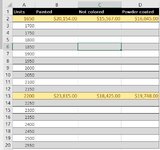Option Explicit
Function Interpolate(X As Double, XRange As Range, YRange As Range, Optional InterpType As Integer = 0) As Variant
' Function returns interpolated value of "Y" for supplied X, based on supplied ranges of known
' X and Y values. Optional "InterpType" argument controls how function responds to X arguments
' outside the known X values:
' If InterpType is:
' = 0: returns an error (default)
' = 1: extrapolates based on last two X-Y pairs (either two highest or two lowest)
' = 2: extrapolates based on first and last X-Y pair (full range of supplied values)
' = 3: extrapolates based on first or last X-Y pair and the origin (0-0)
' Other values return an error
' Function is based on the "InterpolateVLOOKUP" UDF developed by Myrna Larson, and published in the
' Excel Expert's E-Letter, which can be found at: http://www.j-walk.com/ss/excel/eee/eee002.txt
Dim blErr As Boolean
Dim iBase As Integer
Dim iComp As Integer
Dim i As Integer
Dim dX0 As Double
Dim dX1 As Double
Dim dY0 As Double
Dim dY1 As Double
Dim Temp As Variant
On Error Resume Next
' ensure that XRange is sorted ascending so match function result is reliable
For i = 1 To XRange.Count - 1
If XRange(i + 1) < XRange(i) Then blErr = True
Next
Temp = WorksheetFunction.Match(X, XRange, 1)
If IsError(Temp) Then
Interpolate = CVErr(Temp)
Else
iBase = CInt(Temp)
Select Case iBase
Case 0
'match function did not find a match - X =< min(XRange)
Select Case InterpType
Case 0
If X = XRange(1) Then 'X is not "less than" lowest value in range, it is equal
iBase = 1
Else 'X is IS < lowest value in range - represents an error
blErr = True
End If
Case 1
iBase = 1
iComp = 2
Case 2
iBase = 1
iComp = XRange.Count
Case 3
iBase = 1
iComp = 0
Case Else
blErr = True
End Select
Case XRange.Count
'match returns last value in XRange, so X is >= max(XRange)
Select Case InterpType
Case 0
If X <> XRange(XRange.Count) Then 'X is IS > highest value in range - represents an error
blErr = True
End If
Case 1
iComp = iBase - 1
Case 2
iComp = 1
Case 3
iComp = 0
Case Else
blErr = True
End Select
Case Else
'match returned position of value next larger than X, within XRange
iComp = iBase + 1
End Select
dX0 = XRange(iBase)
dY0 = YRange(iBase)
If X = dX0 Then
Interpolate = dY0
Else
dX1 = XRange(iComp)
dY1 = YRange(iComp)
End If
If blErr = True Then
Err.Raise Number:=11
Interpolate = CVErr(Err)
'return "div0" error, to ensure that error propagates through s/sheet calculations
Else
Interpolate = (X - dX0) / (dX1 - dX0) * (dY1 - dY0) + dY0
End If
End If
End Function






